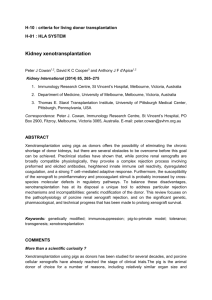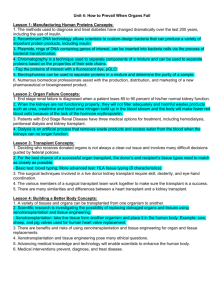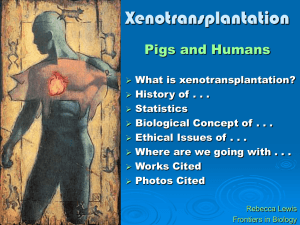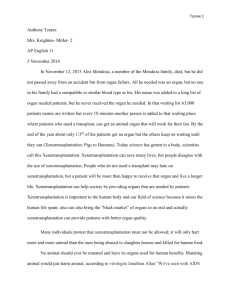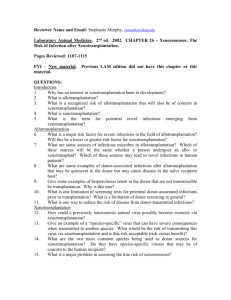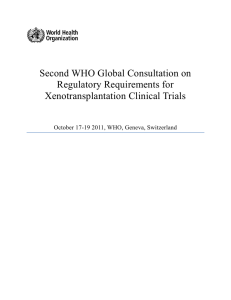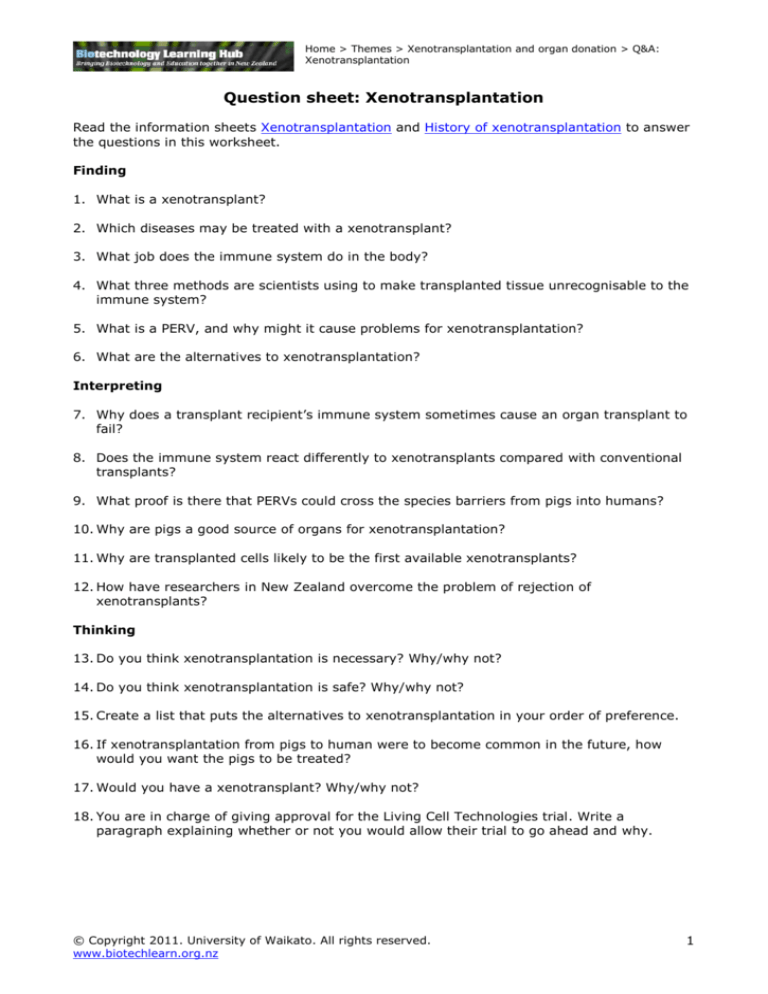
Home > Themes > Xenotransplantation and organ donation > Q&A:
Xenotransplantation
Question sheet: Xenotransplantation
Read the information sheets Xenotransplantation and History of xenotransplantation to answer
the questions in this worksheet.
Finding
1. What is a xenotransplant?
2. Which diseases may be treated with a xenotransplant?
3. What job does the immune system do in the body?
4. What three methods are scientists using to make transplanted tissue unrecognisable to the
immune system?
5. What is a PERV, and why might it cause problems for xenotransplantation?
6. What are the alternatives to xenotransplantation?
Interpreting
7. Why does a transplant recipient’s immune system sometimes cause an organ transplant to
fail?
8. Does the immune system react differently to xenotransplants compared with conventional
transplants?
9. What proof is there that PERVs could cross the species barriers from pigs into humans?
10. Why are pigs a good source of organs for xenotransplantation?
11. Why are transplanted cells likely to be the first available xenotransplants?
12. How have researchers in New Zealand overcome the problem of rejection of
xenotransplants?
Thinking
13. Do you think xenotransplantation is necessary? Why/why not?
14. Do you think xenotransplantation is safe? Why/why not?
15. Create a list that puts the alternatives to xenotransplantation in your order of preference.
16. If xenotransplantation from pigs to human were to become common in the future, how
would you want the pigs to be treated?
17. Would you have a xenotransplant? Why/why not?
18. You are in charge of giving approval for the Living Cell Technologies trial. Write a
paragraph explaining whether or not you would allow their trial to go ahead and why.
© Copyright 2011. University of Waikato. All rights reserved.
www.biotechlearn.org.nz
1
Home > Themes > Xenotransplantation and organ donation > Q&A:
Xenotransplantation
Answer sheet: Xenotransplantation
Finding
1. What is a xenotransplant?
A xenotransplant is when cells, tissues or organs are taken from one species and put into
another to treat disease.
2. Which diseases may be treated with a xenotransplant?
Xenotransplantation may be used to treat Parkinson’s disease, diabetes and organ failure.
3. What job does the immune system do in the body?
The immune system’s job is to recognise and attack foreign cells and tissues.
4. What three methods are scientists using to make transplanted tissue unrecognisable to the
immune system?
Suppressing the immune system.
Genetically engineering the donor cells to produce human proteins that disguise the
cells so the immune system thinks they are part of their own tissue.
Giving the donor cells a seaweed-based ‘invisibility’ coat.
5. What is a PERV, and why might it cause problems for xenotransplantation?
PERV (or porcine endogenous retrovirus) is a type of pig virus. If PERVs become able to
infect humans, they could potentially spread through the population.
6. What are the alternatives to xenotransplantation?
Reducing demand for organ transplants by getting people to live a healthier lifestyle.
Increasing the number of organs available.
In the future, using artificial tissues like pacemakers.
Growing replacement organs from human stem cells.
Interpreting
7. Why does a transplant recipient’s immune system sometimes cause an organ transplant to
fail?
It recognises the transplant tissue as foreign and attacks it, leading to rejection of the
transplanted tissue.
8. Does the immune system react differently to xenotransplants compared with conventional
transplants?
The immune system will attack xenotransplants more readily than normal transplants
because the tissue types cannot be matched. This is called hyperacute rejection.
9. What proof is there that PERVs could cross the species barriers from pigs into humans?
There is no proof of PERVs crossing the species barriers from pigs into humans, but in
1997, a research lab found PERV from a pig cell line could infect human cells in a test tube.
Additional info: Experiments where pig tissue has been transplanted into
immunosuppressed mice have shown that the virus is transmitted to the mouse and
becomes embedded in their genomes in the same way that the virus is embedded in the
pig genome. In pigs, the virus is harmless and causes no infection. It is possible that this
may continue to be the case in other species, but it is also possible that the virus may
evolve to become active and virulent in a new host. Xenotransplant research was halted in
1997 around the world because of concerns about virus transmission. However, in 2005,
the ban was lifted, and xenotransplant research is now being carried out in some countries.
The New Zealand government assess proposals for xenotransplant research on a case-bycase basis.
© Copyright 2011. University of Waikato. All rights reserved.
www.biotechlearn.org.nz
2
Home > Themes > Xenotransplantation and organ donation > Q&A:
Xenotransplantation
10. Why are pigs a good source of organs for xenotransplantation?
They are easy to breed and have large litters.
Pathogen-free pig breeds are available.
Pig organs are a similar size to human organs.
Risk of infectious diseases is lower than in non-human primates.
Pigs are already killed for food, so using pigs may raise fewer ethical concerns than
non-human primates.
11. Why are transplanted cells likely to be the first available xenotransplants?
Cells are easier to protect from the transplant recipient’s immune system than organs.
12. How have researchers in New Zealand overcome the problem of rejection of
xenotransplants?
Using a seaweed-based coating that protects the cells from the immune system. The
coating forms a semi-permeable barrier that immune system antibodies cannot cross.
Thinking
13. Do you think xenotransplantation is necessary? Why/why not?
Yes – there is a huge organ shortfall that is never going to be covered by human organ
donation.
No – using organs from another species to prolong the life of a human being is
physically/morally/religiously repugnant.
14. Do
you think xenotransplantation is safe? Why/why not?
Yes – no evidence has been found of disease transmission from pigs to humans.
Yes – as safe as human to human transplants – the risks are the same.
No – increased risk of organ rejection plus risk of cross-species pathogen transmission
makes it unsafe.
No – risk of cross-species pathogen transmission makes xenotransplantation unsafe,
not only to the organ recipient but to everyone in contact with them.
15. Create a list that puts the alternatives to xenotransplantation in your order of preference.
This can be used as a point of discussion amongst the students.
16. If xenotransplantation from pigs to human were to become common in the future, how
would you want the pigs to be treated?
The pigs would need to be:
kept in disease-free conditions and in optimum health for their lifespan
treated with respect
killed quickly and humanely.
17. Would you have a xenotransplant? Why/why not?
Yes – if my life depended on it; there were no human organs available for transplant;
more research was done.
No – I could not sacrifice a pig in order for me to live; the thought of living with part of
a pig inside me is unacceptable due to religious/moral beliefs…
18. You are in charge of giving approval for the Living Cell Technologies trial. Write a
paragraph explaining whether or not you would allow their trial to go ahead and why.
Students should include 3–4 points for or against the research in giving or denying their
approval. These could include:
risk of disease transmission (to patient and/or human population as a whole)
benefits to people with type 1 diabetes
problem of limited amounts of human donor tissue for transplanting
individual rights to treatment
animal welfare
cultural, spiritual or religious views.
© Copyright 2011. University of Waikato. All rights reserved.
www.biotechlearn.org.nz
3

